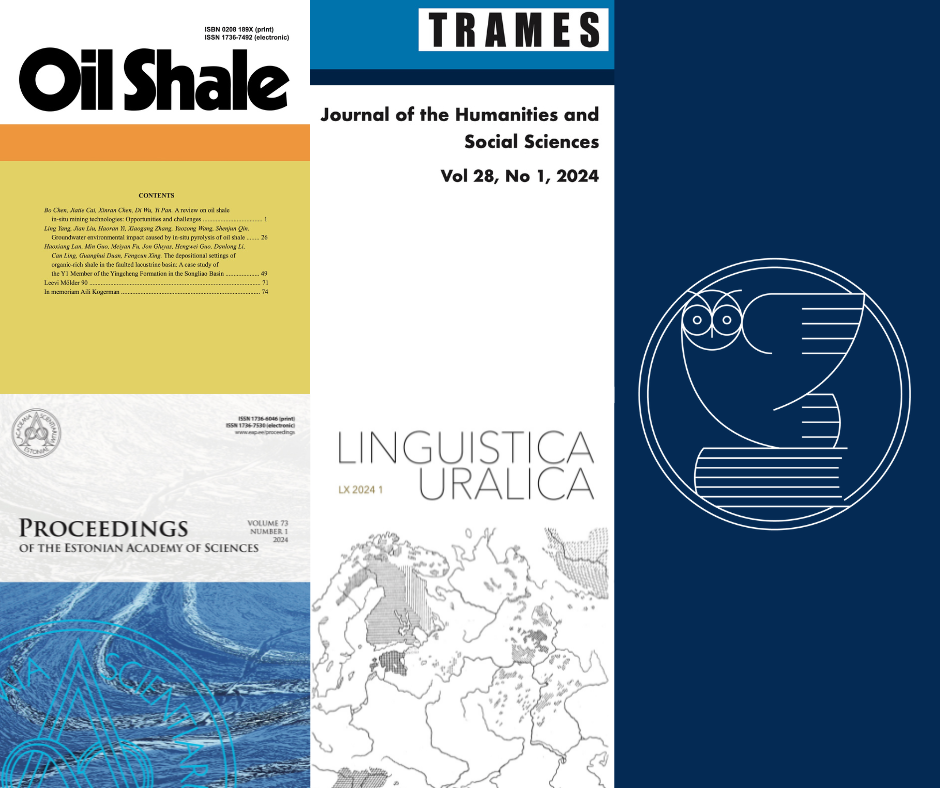The new issues of the scientific journals Linguistica Uralica, Oil Shale, Proceedings of the Estonian Academy of Sciences and Trames have been published.
Brief reviews of the journals:
LINGUISTICA URALICA
One of the most intricate problems in diachronic Finno-Ugric studies is Proto-Ugric, for which there is no commonly accepted reconstruction. Contributions to Ugric etymology are therefore highly welcome. In the March issue of Linguistica Uralica, Sampsa Holopainen from the University of Helsinki investigates problems with the reconstruction of an affricate phoneme *ć and its reflexes in Hungarian. Its alleged reflexes in Hungarian show unexplained variation s ~ z ~ cs, and many of the etymologies involve other phonological irregularities. The Ugric etymologies suggested in earlier etymological sources are analysed and new solutions to the problem of Proto-Ugric *ć and its reflexes in Hungarian are suggested. As the discussion shows, Ugric etymologies allegedly showing Proto-Ugric *ć involve severe problems, and many of the etymologies should be rejected.
OIL SHALE
The latest issue of Oil Shale contains three articles by authors from China. Two of these articles address the specific features of underground extraction technology for oil shale. We would like to highlight the article titled ‘A review on oil shale in-situ mining technologies: Opportunities and challenges’. This comprehensive review emphasizes the efficiency and environmental friendliness of the oil shale in-situ mining technology. This technology proves adept at extracting deep oil shale to produce shale oil, while reducing pollution and greenhouse effect. Based on the data collected, this paper summarizes the development of global underground in-situ oil shale mining technology, introduces four heating transfer principles and mathematical models of conduction heating, convection heating, radiation heating and combustion heating, clarifies the process flow, and presents the advantages and disadvantages of different technologies. It provides a reference for the research of oil shale in-situ mining technology and explores its potential for industrialization and integration with greenization, information and intelligence.
PROCEEDINGS OF THE ESTONIAN ACADEMY OF SCIENCES
The March 2024 issue of the Proceedings of the Estonian Academy of Sciences contains ten articles by scientists from Estonia and abroad, covering topics from organic chemistry to optical solitons, biopolymers, algebra and many more.
Daniil Valme and his co-authors from the Tallinn University of Technology write that road surface condition monitoring is one of the most crucial tasks for vehicle perception systems. The presence of water, snow, ice, or any other substance on the road surface directly affects the rolling resistance and controllability of the vehicle, which is directly related to the safety of the traffic participants. Many sensors, such as RGB cameras, infrared sensors, and mmWave sensors, are used to monitor and inspect road surfaces. The research aims to provide a tool to segment an input image into correct classes. The effectiveness of the developed algorithm in several case studies is presented, and it is verified that the low number of iterations is enough to detect water, snow, and ice on the road surface.
Several results about one-sided duo rings and duo rings are generalized from the case of unital rings to the case of arbitrary associative rings in the article by Mart Abel and Eva-Lotta Elmanovitš from Tallinn University. The research presented by Dmitri Goljandin et al. from Tallinn University of Technology highlights the potential trends for recycling WPCBs (waste printed circuit boards). Viktor Abramov (University of Tartu) and Olga Liivapuu (Estonian University of Life Sciences) propose the notion of a transposed Poisson superalgebra.
TRAMES. A JOURNAL OF THE HUMANITIES AND SOCIAL SCIENCES
The opening article in the first issue of Trames 2024 is by Czech and Slovak researchers Matúš Jevčák and Alexandra Fratrič about Türkiye’s influence operations in Bosnia and Herzegovina. It analyses Türkiye’s diplomacy, public diplomacy, information operations, economic operations, and clandestine and military operations. This enables Türkiye to maintain constructive relations with representatives of the three main ethnic groups and act as a mediator during Bosnia and Herzegovina’s internal crises. The negative side of Türkiye’s influence operations is evident in corruption, the erosion of democratic institutions, the exportation of Türkiye’s internal issues to Bosnia and Herzegovina, and the undermining of the EU’s influence in the country.
The next contribution is the Israeli author Gadi Hitman’s comparative article about political violence in Hungary and Israel. The main consequence of violence is the transition of democratic regime to a non-democratic one. In Israel, political violence is mainly verbal, whereas in Hungary, it is hurting political opponents. Violence has a direct impact on the national-religious identity of both countries.
Chinese scholars Meiou Zhao and Jiyong Geng tackle the ecocritical translation studies. They also rely on the work of Estonian semioticians Kalevi Kull and Peeter Torop.
Tomaž Krpič from Slovenia analyses the change in the work of the painter Ive Šubic and his depiction of hands. After World War II, he was held in high regard by the communist authorities for his paintings of partisans in Slovenia, but after the mid-1950s, the artist withdrew from public life and yearned for rural life of the past that was already part of the lost world.
Ani Rostiyati et al. examine the nondoi ritual of East Kalimantan paser people, and how they might be influenced by the planned new capital of Indonesia, Nusantara.
The last contribution is by Nigerian researchers Damilola Waliyullahi Abimbola et al. who take a look at the identity crisis of the Russian language in Ukraine.
